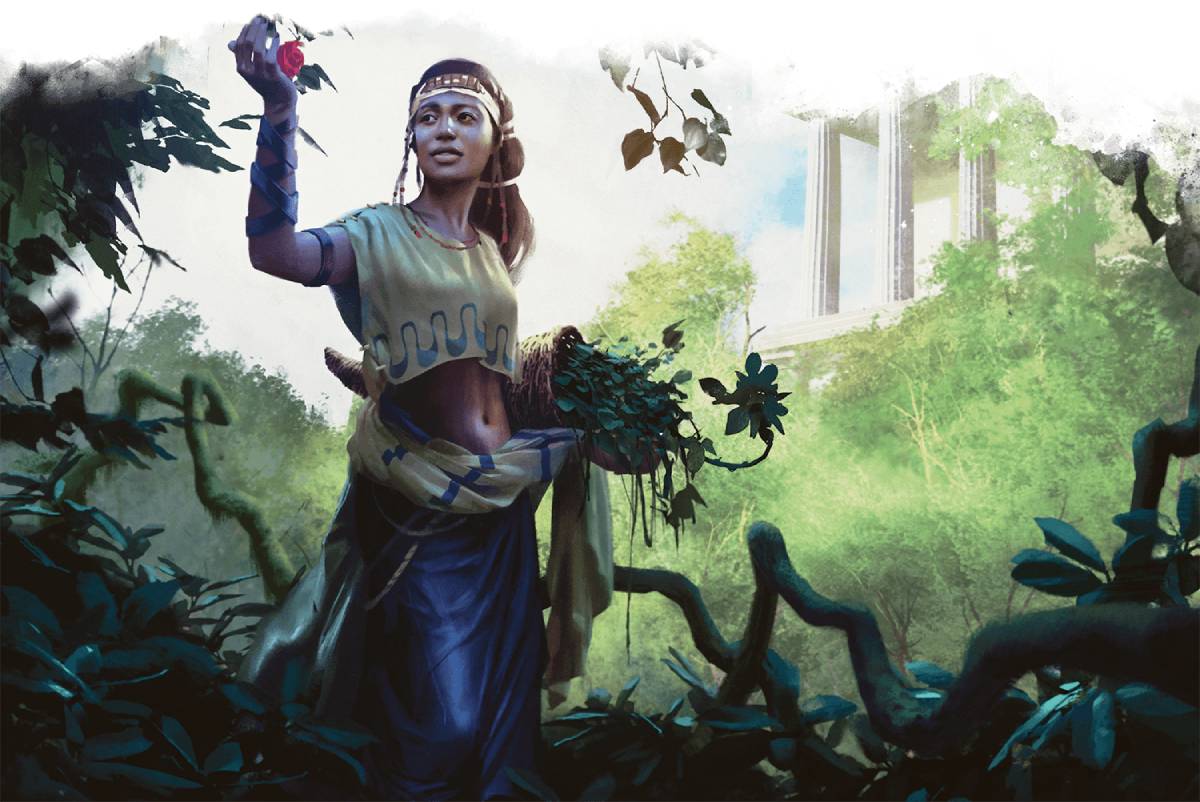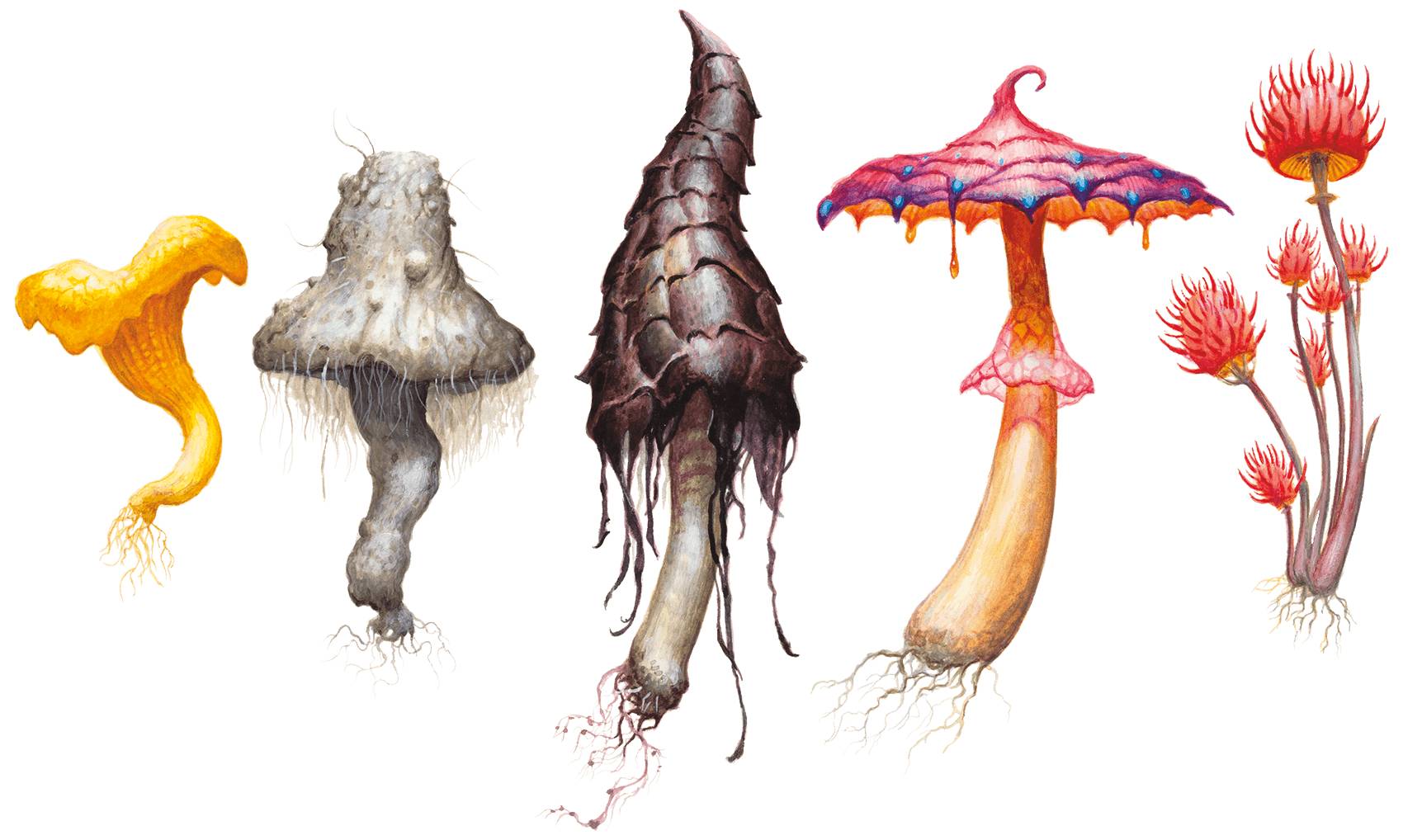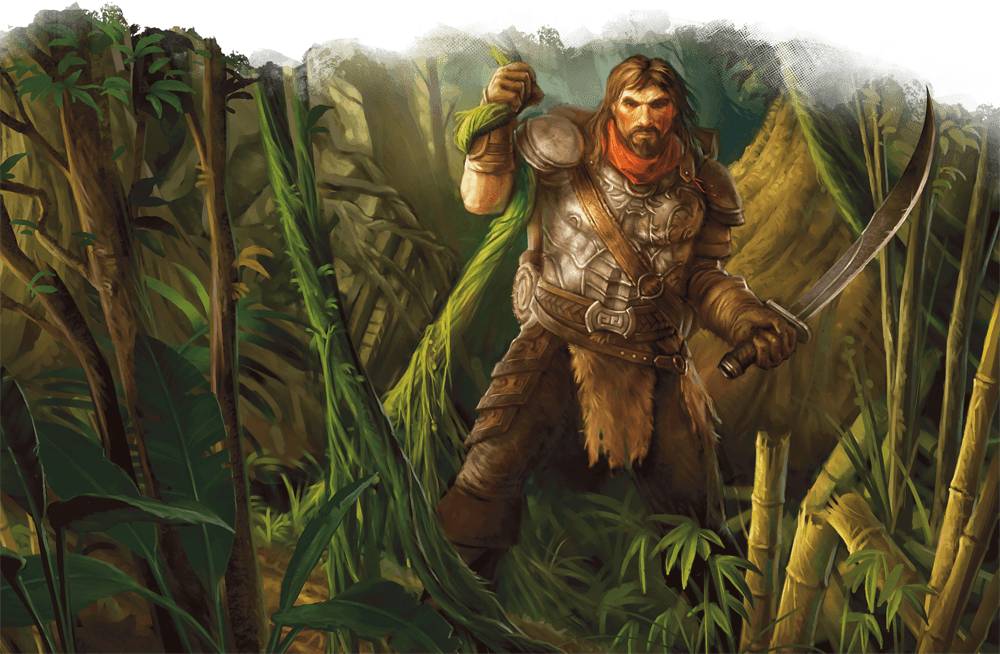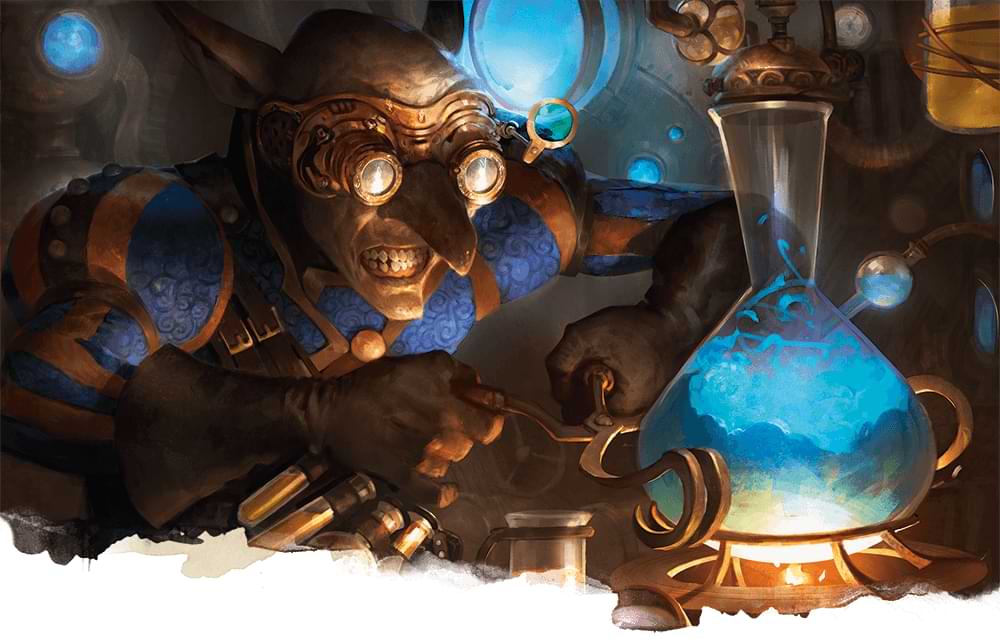Are you a wizard scavenging in the forest for spell components? Or perhaps a ranger searching for a herb that’ll help your injured halfling buddy? Maybe you’re just a druid looking for their next lunch.
In the D&D multiverse, there are bound to be countless magical plants that can be found on your adventures. In this horticultural guide, we’ll explore some ways to incorporate plants into your D&D campaign using homebrew and official rules!
Why Use Plants?

Plants are the perfect worldbuilding piece to establish ground rules for certain lore and help players immerse themselves in the setting. Understanding the ways that civilizations grow and harvest their food, create medicine, and even enchant items through the use of plants can give players something concrete to grasp on to, which is important for roleplaying games where the world exists in the players’ minds.
Beyond providing a foundation for your setting, these ground rules can offer interesting plot hooks, useful expendable resources, and help players come up with creative solutions to problems.
Homebrew Plants for Your Game

A “useful” plant very much depends on the context of the goal your players are trying to achieve. Poisonous plants aren’t what they'd be looking for when trying to make a salad, but these deadly plants can be just what your party may need when they’re trying to off a rival.
In the below table, you’ll find 20 homebrew plants and their effects, which you can use to flesh out the flora of your campaign world. The plant’s inclusion in your game, necessary preparations, and effects are entirely up to you as the DM. Consuming or using any of the plants below is considered a [Tooltip Not Found] action.
| d20 | Plant | Effect |
| 1 | Nightshade | The key ingredient in the assassin’s blood poison. |
| 2 | Silverthorn | When brewed under moonlight for 8 hours, this plant can create a potion that gives advantage on Constitution saving throws against lycanthropy that lasts for 24 hours. |
| 3 | Bloodroot | When boiled and muddled, this plant can make for convincing fake blood. |
| 4 | Dragon's Tongue | After being cooked for 1d4 hours, this spicy pepper deals 2d8 fire damage to the creature that eats it and gives them one free 1st-level casting of burning hands (DC 13), which is expelled out their mouth. |
| 5 | Winter's Bite | A blue leafy plant that grows in tundras. This plant can be brewed into a potion of resistance specifically for cold damage. |
| 6 | Dreamleaf | The main ingredient of the essence of ether poison. |
| 7 | Bloomlotus | A beautiful flower found floating on remote ponds. When properly preserved it is a highly coveted decorative item for the wealthy. |
| 8 | Firethorn | An exceedingly rare plant that is dangerous to harvest but provides wielders with a flame tongue dagger that breaks after 1d4 successful attacks. |
| 9 | Weavegrass | The plant of choice for making cloaks of elvenkind. |
| 10 | Liferoot | The key ingredient for potions of healing. |
| 11 | Starbloom | When distilled under starlight for 8 hours, the liquid from this plant can be splashed over a 20-foot cube to apply the effects of the faerie fire spell for 1 minute. (DC 13) (No concentration needed.) |
| 12 | Rotshroom | This fungi can only be found in the Underdark and can be used to make drow poison when combined with spider venom. |
| 13 | Mindthorn | The main ingredient of the truth serum poison. |
| 14 | Gravedust | A thorny plant that grows in graveyards. This plant can be brewed into a potion of resistance specifically for necrotic damage. |
| 15 | Zapthistle | A tall, wispy plant that grows on high mountains. This plant can be brewed into a potion of resistance specifically for lightning damage. |
| 16 | Siren's Call | The main ingredient in the philter of love potion. |
| 17 | Death's Beckon | A pale plant that grows deep in forests. This plant is the main ingredient in the midnight tears poison. |
| 18 | Shadowleaf | An extremely rare plant that is the main ingredient of potions of invisibility. |
| 19 | Cinderroot | Native to volcanic regions, this plant can be brewed into a potion of resistance specifically for fire damage. |
| 20 | Graveflower | When brewed and buried in the ground for 1d6 days, this can be poured into a corpse's mouth to cast speak with dead. |
Finding and Identifying Plants

If your players are looking to gain the upper hand in combat, craft a magical item, or brew a potent potion, they might need to find a specific plant or herb (such as the ones listed in the Homebrewed Plants and Effects table).
Below are some suggested checks that may allow them to discover more about the flora they’re looking for based on their character’s strengths. Keep in mind, these aren’t official rules and you as the DM make the final call about which check is needed in certain scenarios.
- Arcana: Have they studied the magical properties of the plant in question?
- Nature: Do they understand which effects are achievable through the use of certain herbs?
- Survival: Do they have enough experience with certain plants and herbs to determine which one they need and how to safely harvest it?
If these checks come up fruitless or if the characters don’t have a good enough understanding of the area or effect they’re hoping to achieve, they may need to consult an expert. Depending on where they are, and the class they’re playing, they’ll have different resources to acquire the knowledge necessary to find the plant they’re looking for:
Gathering Plant Knowledge
| Location | How to Acquire Information |
| Apothecary | The more sensitive the information, the more they can expect to pay. (Acquire with gold.) |
| Library | Hit the books to find the information they seek. (Research with Nature or Investigation.) |
| Nearby Druid Circle | Appeal to their love of nature and desire for its protection. (Negotiate with Persuasion or a quest.) |
| Witch or Hag | Make a dangerous bargain for the information. (Complete a quest or make a trade.) |
| Black Market | This will cost them dearly but is useful when they need access to forbidden plants. (Acquire with Intimidation, Deception, or gold.) |
Okay, the characters now know what kind of plant they’re looking for and the general area it might be in. What next? Well, I hope they had the wherewithal to buy an herbalism kit while they were visiting the apothecary because it’s going to make things a lot easier.
Using an Herbalism Kit
If your players have proficiency with an herbalism kit and have one on hand, identifying plants and safely collecting their useful elements is much easier.
In the Tool Proficiencies section of Xanathar’s Guide to Everything, it’s stated that players can get advantage on checks associated with a certain area of expertise as long as they’re proficient with both the necessary tool and a skill that applies to the check.
Further on down the section, these related checks and added benefits are provided for the herbalism kit:
Herbalism Kit
Proficiency with an herbalism kit allows you to identify plants and safely collect their useful elements.
Components. An herbalism kit includes pouches to store herbs, clippers and leather gloves for collecting plants, a mortar and pestle, and several glass jars.
Arcana. Your knowledge of the nature and uses of herbs can add insight to your magical studies that deal with plants and your attempts to identify potions.
Investigation. When you inspect an area overgrown with plants, your proficiency can help you pick out details and clues that others might miss.
Medicine. Your mastery of herbalism improves your ability to treat illnesses and wounds by augmenting your methods of care with medicinal plants.
Nature and Survival. When you travel in the wild, your skill in herbalism makes it easier to identify plants and spot sources of food that others might overlook.
Identify Plants. You can identify most plants with a quick inspection of their appearance and smell.
Herbalism Kit
Activity DC Find plants 15 Identify poison 20
Finding and Gathering Plants Without an Herbalism Kit
If they didn’t happen to grab an herbalism kit before heading out into the wilderness, we can pull applicable skill checks and DCs from the Arcane Herbology Exam: Vegetation Identification in Strixhaven: A Curriculum of Chaos to give us an idea of the expected checks required:
Flora’s Arcane Properties. Correctly selecting the properties of samples requires a successful DC 13 Intelligence (Nature) check.
Specimen Identification. Recalling the correct names of flora with arcane uses based on sight, smell, and texture requires a successful DC 20 Wisdom (Survival) check.
So, while identifying plants is such a trivial task it doesn’t need a check with an herbalism kit, without one it requires distinct knowledge and a shrewd eye.
Likewise, you can conceivably collect samples without a DC as long as you have proficiency with an herbalism kit and have one on hand, but you’d need to succeed on a DC 13 Intelligence (Nature) check without one.
Ultimately, these checks and DCs are up to you as the DM and will shift based on the environment, the plant in question, and any other roadblocks that are present. Still, they’re a good baseline to understand what your players can do when it comes to attempting to find and harvest plants in D&D.
Crafting With Plants

Your players have discovered the plant they're looking for based on its properties, gone to the apothecary to find where it's harvested, traversed the wilderness to find the plant, took the painstaking precautions to harvest it, and, finally, it is in their grasp. Great! What next?
Crafting can be tricky in D&D, as its efficiency as written is entirely dependent on the type of campaign you're running. If you're running a campaign that includes weeks or months of downtime, then the rules for crafting may work fine as is.
If, however, the event where your players are hoping to use their newly acquired plant to poison a corrupt noble is tomorrow night, you may need to come up with your own rules for crafting so they can fit your use case better. You could also use the expanded crafting rules in Xanathar's Guide to Everything, as it fleshes out rules for crafting potions of healing and other magic items, which could be applied to other potions or equipment your players are hoping to create.
One thing that I would suggest is, if a player goes to the lengths to find and harvest a specific plant for the item they're looking to craft, consider dropping the DC, cost, or even time required to complete their goal. For example, if one of my players discovered that liferoot was the key ingredient of a potion of healing and made a point to collect some, I would drop the 25 gp cost associated with crafting the potion.
Enjoy Your Foraging!
So, now you know what plants to include in your game, how your players can find them, and what they can do with them once they’ve got them! Please note that D&D Beyond is not responsible for any stings, scratches, or poisonous bites your players sustain when searching the forest for plants to harvest.
Mike Bernier (@arcane_eye) is the founder of Arcane Eye, a site focused on providing useful tips and tricks to all those involved in the world of D&D. Outside of writing for Arcane Eye, Mike spends most of his time playing games, hiking with his girlfriend, and tending the veritable jungle of houseplants that have invaded his house.








-
View User Profile
-
Send Message
Posted Apr 26, 2023I feel like this is a good place to plug my buddy's Plant-focused homebrew
https://www.drivethrurpg.com/product/395466/Lancers-Arcane-Botanica-Vol-1
I've used a few in my own games and it's a pretty neat addition to any DMs bookshelf for those who need plants
-
View User Profile
-
Send Message
Posted Apr 27, 2023I had a DM that said that my Druid had to use his Nature skill if he was going to forage for herbs and the like he could use for making potions, though if I had Medicine I could use that. He wasn't proficient in either, but he was proficient with his herbalism kit, so it was a straight proficiency roll but since I was indicating that I was doing it as part of my downtime activity I could do it a number of times in conjuncture of how much time out of my day I'd spend using it.
Point is that there are two additional proficiency skills you have to use if you want to look for plants, so my recommendation is proficiency+skill (WIS or INT) plus any bonuses granted by your situation.
-
View User Profile
-
Send Message
Posted Apr 27, 2023Why is a truth serum a posion and not a potion?
-
View User Profile
-
Send Message
Posted Apr 27, 2023The stuff in a truth serum IS a poison if anything but the minor doses administered, it's basically a neural toxin.
-
View User Profile
-
Send Message
Posted Apr 27, 2023Since I see other folks posting links to other PDFs about poisons, I'll go ahead and post this one, which is very highly rated by customers and features a lot of opportunities for crafting herbal and alchemical substances like bug repellant and weapon poisons, all based on real world plants:
https://www.drivethrurpg.com/product/377563/Poisonous-Plants ?affiliate_id=76849
-
View User Profile
-
Send Message
Posted Apr 27, 2023This is great! Please more of these kind of articles!!
-
View User Profile
-
Send Message
Posted Apr 27, 2023Put this in the revised Core 3 books next year, or else what's the point?
Also, should have been a d100 table of plants. Quit slacking.
-
View User Profile
-
Send Message
Posted Apr 27, 2023This is a great way to make the world feel more alive, thank you!
-
View User Profile
-
Send Message
Posted Apr 28, 2023This is really neat. Thank you. I would love to see more in depth articles about using other tools and using the wilderness for crafting.
-
View User Profile
-
Send Message
Posted Apr 28, 2023Great use of plants I will be using this for DM-ing.
-
View User Profile
-
Send Message
Posted Apr 29, 2023This is a really cool article.
-
View User Profile
-
Send Message
Posted May 1, 2023Excellent article, this is what we need more of :)
-
View User Profile
-
Send Message
Posted May 3, 2023Very good article. I didn't knew I need it, but now that I discover it, I want to use it right now.
-
View User Profile
-
Send Message
Posted May 3, 2023easily using this in my next campaign
-
View User Profile
-
Send Message
Posted May 3, 2023Great article! I'll probably take some of this to fit into my current system.
I handle looking for natural components a little differently. Instead of having the D20 list of plants I have the player tell me what they are trying to make. Say an invisibility potion. Then depending on the rarity I set the DC to decide if they can find a component. That way I don't have to have hundreds of plants identified as components for everything. I also adjust the DC depending on terrain type. If they're in an old growth forest that's going to be easier to collect certain components than if you're in the desert.
-
View User Profile
-
Send Message
Posted May 4, 2023Awesome. One of the best articles I've seen here. I really want to make a botanist now!
-
View User Profile
-
Send Message
Posted May 5, 2023Man, I love crafting in TTRPGs so much (which is why I play an Alchemist). I also think it's very important to have semi-concrete mechanics for how it works. I'm definitely gonna this page in the hope of using it in the future. Thanks, Mike, God bless you!
-
View User Profile
-
Send Message
Posted May 15, 2023I really love this and I truly hope my DM will implement some of this in our next campaign!
-
View User Profile
-
Send Message
Posted May 18, 2023I wish there were a "Bookmark" function on DNDBeyond. This is great stuff !!
-
View User Profile
-
Send Message
Posted May 18, 2023So next time when a campaign is m ore focused on the environment, I need to have a herbalist and an alchemist either as PCs or NPCs.